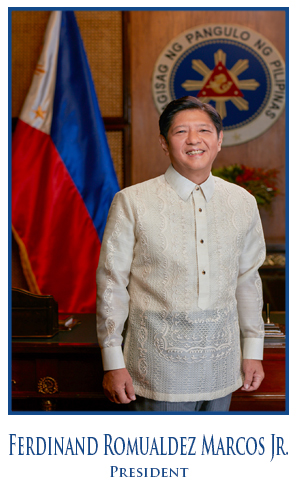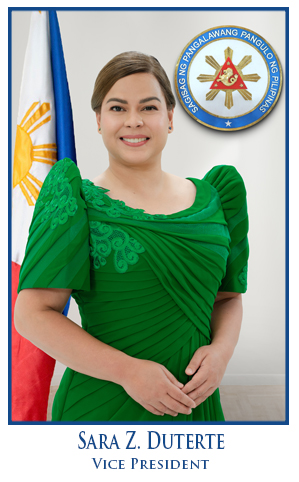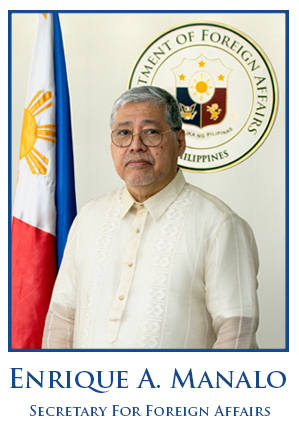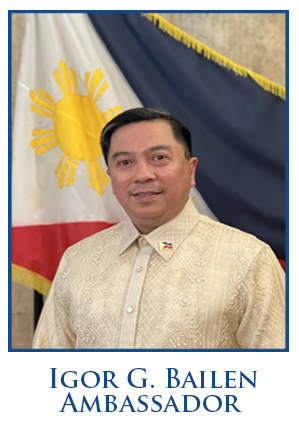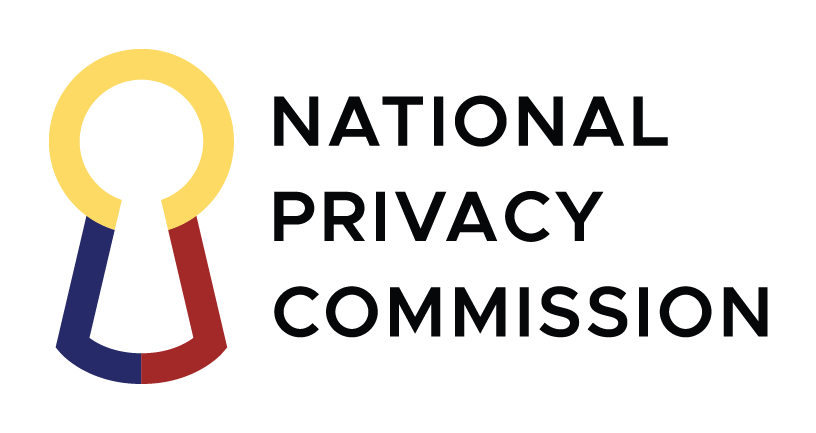Why do business and invest in the Philippines?
Strategic geographic location
The Philippines lies in the heart of Asia, today’s fastest growing economic region.
Its strategic location makes it a potential gateway to more than 550 million peoples in the Southeast Asian market.
It is less than two hours to Hong Kong and within four hours flying time from Southeast Asian capital cities and most major cities in Asia.
It lies astride major international shipping and air lanes, making it suitable for European businesses.
Abundant mineral resources
The Philippines abounds in both metallic and non-metallic mineral resources. It is the biggest copper producer in Southeast Asia and among the top ten producers of gold in the world. Other metallic minerals found in the Philippines include cadmium, chromium, iron, manganese, mercury, molybdenum, nickel, silver, and zinc.
Non-metallic mineral resources consist of asbestos, asphalt, coal, guano, gypsum, limestone, marble, petroleum, phosphate rock, salt, silica, and sulphur.
Quality human resources
The Philippines has a highly skilled and educated workforce that speaks very good English. English is widely spoken throughout the archipelago and is the official business language.
It is the world’s third largest English-speaking country and produces close to 400,000 graduates a year, adding to an already large professional pool.
It has a literacy rate of 94.6%, which is among the highest in the region.
Its people are friendly and are familiar to the cultures of the East and the West, making the country an ideal second home to expatriates and providing a comfort level for most European business people.
Infrastructure
The Philippines has a well-developed network of communications and transportation infrastructure that links the three largest islands of Luzon, Visayas and Mindanao. These islands are highly accessible by land, water and cyberspace.
Its specialized IT zones provide ready-to-occupy offices and production facilities, computer security and building monitoring systems, as well as complete office services.
Communications System and Facilities
The communications system provides international connectivity 24/7 with fiber optic cable as primary backbone network and satellite as backup.
Manila and other regional business centers have a modern and efficient telephone service that can directly connect to anywhere in the world.
There are several television stations providing local and international programming and hundreds of AM and FM stations, most of which use English as the medium of communications.
Cable TV is widely available throughout the country.
Newspaper dailies are generally in English. International newspapers and magazines are available in bookshops, hotels, and other establishments.
Airports and Ports
There are six (6) international airports: the Ninoy Aquino International Airport in Manila is the country’ main international gateway, serving more than 30 airlines, which fly to different cities around the world. The others include Laoag, Subic and Clark in Luzon, Cebu in the Visayas and Davao in Mindanao.
There is also a number of international port cities, including Manila, Batangas and Subic in Luzon; Cebu and Iloilo in the Visayas; and Davao in Mindanao.
Container terminals are suited to handle cargo traffic at the highest level of efficiency.
Hospitable and Affordable Luxurious Lifestyle
The Philippines is often voted as one of the most livable countries in Asia for expatriates.
It has increasingly become a favorite tourist destination, with its scenic spots, world-class business and recreation centers, and luxury holiday destinations at affordable prices.
It has a global outlook and tolerance for varied cultures.
Liberalized and Business-Friendly Economy
Government policy actively encourages foreign investments in practically all sectors of the economy and provides incentives to investment activities that encourage national development.
Foreign ownership is allowed in almost all sectors and the Build-Operate-Transfer (BOT) investment scheme is a major enabling mechanism for partnerships.
Incentive packages that include corporate income tax, reduced to its current 32% are provided, while companies operating in special economic zones are subject only to 5% overall tax rates.
There are many economic zones that offer a wide range of incentives and tax exemptions for companies locating their operations in these zones.
Multinationals with regional headquarters in the country are given incentives such as tax exemption and tax and duty-free importation of specific equipment and materials.
The banking, insurance, shipping, telecommunications and power industries have been deregulated and a number of government corporations are being privatized.
Economic reforms emphasize regional growth, converting remote areas into business centers.
Philippine Priority Sectors
The Philippines identifies the following sectors as priority for foreign investments under its Medium Term Development Plan:
a. Information and Communications Technology (ICT) services
b. Automotive
c. Electronics
d. Mining
e. Health care and wellness
f. Tourism
g. Shipbuilding
h. Fashion garments
i. Jewelry
j. Agribusiness
Hot Sectors for Foreign Investors
1. Mining
The Philippines is rich in mineral resources particularly in gold and copper. The Mining Act of 1995 liberalized the mining industry by allowing the entry of foreign mining firms and by granting a package of incentives to investors.
2. Renewable Energy Sources
The Philippines is aggressively pushing for the development of its indigenous renewable energy sources. Under the Philippine Energy Plan, the Government aims to exploit indigenous energy resources to reduce energy imports and eventually make the country self-sufficient in energy sources. Reforms are under way to encourage private sector participation and investments in the development of renewable energy. The passage of House Bill 1068, otherwise known as An Act to Promote the Development, Utilization, and Commercialization of Renewable Energy Sources; is expected to speed up the development of renewable energy resources by giving fiscal and non-fiscal incentives to renewable energy developers.
3. BPO
The Philippines has emerged as a favorite destination and hub in Asia for outsourcing of information and communication technology (ICT) and business process (BP) owing to its IT-trained, English-speaking, high quality and cost-effective workers, and modern ICT infrastructure.
The Philippine government grants incentives to outsourcing companies engaged in ICT. In addition, international connectivity, multi-media infrastructure and deregulated telecommunications industry are in place to promote the Philippines as a top destination for business process outsourcing.
4. Tourism Infrastructure and Facilities
The Philippine Government encourages foreign investment in tourism-related projects such as tourist accommodation facilities, tourism estates, historic-cultural heritage projects and tourist bus operations. Foreign investments on these projects are entitled to BOI incentives.
FREQUENTLY ASKED QUESTIONS ON INVESTMENT IN THE PHILIPPINES
Q. What are the requirements before a foreign corporation can engage in business in the Philippines?
It must first secure the necessary licenses or registration certificates from the appropriate government agencies. Generally, the registration process starts with the Securities and Exchange Commission (SEC), the government agency responsible for the registration, licensing, regulation and supervision of all corporations licensed to engage in business or to establish a branch office in the Philippines.
If the proposed project or activity qualifies for incentives, the foreign corporation may file its application with the appropriate government agency depending on the project’s location, as follows:
11. Board of Investments (BOI). Website: www.boi.gov.ph. For projects outside the special economic zones
12. Philippine Economic Zone Authority (PEZA). Website: www.peza.gov.ph. For projects in any Special Economic Zone under PEZA
13. Subic Bay Metropolitan Authority (SBMA). Website: www.sbma.com. For projects in Subic Bay Freeport
14. Clark Development Authority (CDC). Website: www.clark.com.ph. For projects in Clark Special Economic Zone
15. John Jay Poro Point Development Corporation. For projects in John Jay Special Economic Zone, Poro Point Freeport and Special Economic Zone
16. Cagayan Economic Zone Authority. Website: www.cagayanfreeport.com. For projects in Cagayan Special Economic Zone
17. Zamboanga Economic Authority. Website: www.zambofreeport.com. For projects in Zamboanga City Special Economic Zone
Q. What areas are open to foreign investments and can a foreign investor own 100% equity in a Philippine business?
Foreign investments in the Philippines have been liberalized with the enactment of the Foreign Investments Act of 1991. Almost all sectors of business is open to 100% foreign equity and investment except financial institutions and those included in the Foreign Investment Negative List (http://www.philembassy-uk.org/content/files/downloads/ForeignInvNegList.pdf) provided in the Foreign Investment Act of 1991 (http://www.philembassy-uk.org/content/files/downloads/ForeignInvAct1991.pdf)
Q. Is the mining industry open for foreign investments?
Yes. Under the Philippine Mining Act of 1995 (http://www.philembassy-uk.org/content/files/downloads/PhilMiningAct1995.pdf), foreign mining firms are now allowed to engage in mining activities in the Philippines and to register with the Bureau of Investments (BOI) for incentives. The Mining Act of 1995 also provides incentives to foreign enterprises engaged in mining in the Philippines.
Q. What is the rate of corporate income tax in the Philippines?
Foreign corporations are taxable on Philippine-sourced income at the same rate as domestic corporations at the rate of 35% starting 01 July 2005 but will be reduced to 30% with effect from 01 January 2009. A licensed foreign corporation will be treated as a resident foreign corporation; subject to the 35% tax on its net Philippine-sourced income. An unlicensed foreign corporation will be treated as a non-resident foreign corporation, subject to 35% tax on its gross Philippine-sourced income.
Branches of foreign corporations are subject to the same corporate tax rate. Branch profit remittances are subject to 15% tax, which can be reduced subject to tax treaty agreements.
Q. Can a foreigner engage in retail/trade in the Philippines?
Yes. Under the Philippine Retail Trade Liberalization Act (Republic Act No. 8762) (http://www.philembassy-uk.org/content/files/downloads/PhilRetailTradeLibAct2000.pdf) foreigners are allowed to engage in retail trade in the Philippines if their paid-up capital is US$2.5 million and above.
Contacts and Links
Additional information and news about trade and investment can be obtained from the Philippine Business Report, a monthly publication of the Information Centre of the Philippine Department of Trade and Industry, by visiting its website: www.business.gov.ph.
Other useful links: www.dti.gov.ph and www.boi.gov.ph. Additional information and news about trade and investment opportunities in the Philippines can be obtained from the Philippine Business Report, a monthly publication of the Information Centre of the Philippine Department of Trade and Industry, by visiting its website: www.business.gov.ph.
OVERVIEW OF PHILIPPINES (PH) –RUSSIAN FEDERATION (RF)
BILATERAL RELATIONS
The history of the Philippine diplomatic mission in Moscow can be divided into two distinct periods: relations with the Union of Soviet Socialist Republics (USSR) from 1976 to 1991 and relations with the Russian Federation and the Soviet successor states from 1992 up to the present.
The Philippines and the USSR agreed to formally establish diplomatic relations during the state visit to the USSR of President and Mrs. Ferdinand E. Marcos from 21 May to 7 June 1976. On 2 June 1976, the Joint Communiqué on the Establishment of Diplomatic Relations between the Philippines and the Union of Soviet Socialist Republics was signed by President Marcos and Mr. Nikolay V. Podgorny, then President of the Presidium of the USSR Supreme Soviet.
Following the dissolution of the USSR in December 1991, the responsibilities and obligations of the Soviet Union arising from bilateral Philippines-USSR agreements were taken over by the Russian Federation, which the Philippines formally recognized on 28 December 1991.
The Philippines and the Russian Federation have since enjoyed cordial and expanding relations.
Philippines-Russia engagement has increased markedly with high-level exchanges of visits and meetings conducted in the past few years, notably the meeting of Philippine President Rodrigo RoaDuterte with Russian President Vladimir Putin at the sidelines of the APEC Economic Leaders’ Meeting in Lima, Peru on 19 November 2016; and President Duterte’s meeting with Russian Prime Minister Dmitry Medvedev at the sidelines of the ASEAN Summit in Vientiane, Lao PDR on 08 September 2016.
During President Duterte’s first meeting with President Putin, both leaders agreed to enhance bilateral relations and cooperation in defense, economic and socio-cultural areas. An invitation to visit Russia was conveyed by President Putin to President Duterte.
During President Duterte’s meeting with Prime Minister Medvedev, the two discussed a wide range of bilateral issues as well as ways which the Philippines and Russia can enhance bilateral relations, particularly in trade and investments, cooperation in combating illegal drugs, and cultural and educational cooperation, among others.
Recent high-level visits to Manila include the visit of Prime Minister Dmitry Medvedev on 18-20 November 2015 for the Asia Pacific Economic Cooperation (APEC) Leaders’ Meeting; Secretary of Security Council Nikolay P. Patrushev on 15-17 February 2017; and Deputy Minister for Economic Development Alexander V. Tsybulskiy, as RF Chair for the PH-RF JCTEC) on 26 January 2017.
Meanwhile, the most recent high-level visit of Philippine officials to Moscow is that of Foreign Affairs Secretary Perfecto R. Yasay and Defense Secretary Delfin N. Lorenzana on 3-6 December 2016. Secretary Yasay called on Foreign Minister Sergey Lavrov, while Secretary Lorenzana called on Deputy Defense Minister Anatoly Antonov and Director Alexander Fomin of the Federation Service for Military Technical Cooperation.
The Philippines and Russia also engage in cordial and active inter-parliamentary relations. Federation Council Chairperson Valentina Matviyenko visited Manila on 10 November 2014. In reciprocation, Senate President Franklin Drilon visited Moscow on 18-23 October 2015, wherein he and Chair Matviyenko signed the “Agreement on Cooperation Between the Council of the Federation of the Federal Assembly of the Russian Federation and the Senate of the Congress of the Republic of the Philippines” on 20 October 2015.
The Philippine Ambassador to the Russian Federation is H.E. Carlos D. Sorreta. The Philippines has Honorary Consulates in Vladivostok, headed by Mr. Yuri M Kostyukov, Consul General, ad honorem; and in St. Petersburg, headed by Mr. Sergey Alexeev, Consul General, ad honorem.
The Russian Federation has a resident diplomatic mission in the Philippines. The Ambassador is H.E. Igor A. Khovaev, who presented his credentials to President Benigno S. Aquino III on 08 June 2015. Russia has an honorary consulate in Cebu City, headed by Ms. Armi Lopez Garcia.
PH-RF JOINT COMMISSION ON TRADE AND ECONOMIC COOPERATION (JCTEC)
The Agreement on the Establishment of the Joint Commission on Trade and Economic Cooperation (JCTEC) was signed by President Benigno S. Aquino III and Prime Ministry Dmitry Medvedev for the Republic of the Philippines and the Russian Federation, respectively,on 18 November 2015 at the sidelines of the APEC Economic Leaders’ Meeting in Manila.
The PH and RF Co-Chairs of the JCTEC, Philippines Department of Trade and Industry Undersecretary Ceferino S. Rodolfo and Russia Deputy Minister for Economic Development Alexander V. Tsybulskiy, held their first Co-Chairs Meeting in Manila on 26 January 2017. During this meeting, the Co-Chairs discussed various areas of cooperation—including trade and investments, agriculture, industry, energy, manufacturing, infrastructure, transport, tourism, science and nuclear technology, labor and higher educated—that will be tabled during the inaugural session of the JCTEC.1 The meeting resulted in the publication of the Joint Statement of the Co-Chairs. (Read it here: http://ow.ly/mz9c30afx0m)
PH-RF BILATERAL TRADE
In 2015, Russia was the Philippines’ 31sttrading partner, 44th export market, and 27th import supplier.
|
Trade2(in US$) |
|||||
|
|
Total |
Exports |
Imports |
Balance |
|
|
2016 (Jan-Nov) |
210,687,588 |
44,189,009 |
166,498,579 |
(122,309,570) |
|
|
2015 |
421,609,749 |
46,311,522 |
375,298,227 |
(328,986,705) |
|
|
2014 |
1,048,270,983 |
67,583,335 |
980,687,648 |
(913,104,313) |
|
|
2013 2012 |
1,357,849,470 1,068,748,959 |
68,370,993 66,487,627 |
1,289,478,477 1,002,261,332 |
(1,221,107,484) (935,773,705) |
|
|
Exports (2015) |
Imports (2015) |
||||
|
|
||||
TOURIST ARRIVALS FROM RUSSIA3
Tourist arrivals from Russia have grown exponentially since 2004, due in part to the 30-day visa-free entry of Russian nationals visiting the Philippines as tourists, instituted on 01 August 2013.
|
2016 (Jan-Oct) |
20,147 |
|
2015 |
25,278 |
|
2014 |
32,087 |
|
2013 |
35,404 |
|
2012 |
28,270 |
REFERENCES
1 Department of Trade and Industry, “Philippines and Russia to Bolster Trade and Investment Ties.” (http://www.dti.gov.ph/about/updates/latest-news/10135-philippines-and-russia-to-bolster-trade-and-investment-ties)
2 Philippine Statistics Authority (PSA) processed by DTI-EMB
3 DOT, Visitor Arrivals to the PH by Country of Residence
EMBASSY NEWS
- PH Embassy in Moscow Promotes Cultural Dialogue Through Tinikling with Russian Students
- PH Embassy in Moscow Supports Efforts of New Era University Toward Strengthening Institutional Linkages
- Statement of Foreign Affairs Secretary Enrique A. Manalo on the 6th Anniversary of the Award on the South China Sea Arbitration
ANNOUNCEMENT

